YVONNE AUDETTE: An Appreciation, The Expatriate Years + Return to Australia
YVONNE AUDETTE | An Appreciation
GERARD VAUGHAN
In his introduction, Christopher Heathcote recalls his first encounter with Yvonne Audette’s work in 1994, and his astonishment that pictures of such quality and sophistication by a contemporary Australian artist could have somehow passed under the radar. Six or seven years later, when I came to the National Gallery of Victoria as Director, I experienced my own moment of discovery, when I saw her abstract paintings for the first time. Like Christopher, I was blown away by their powerful presence, the sheer quality of her painting method, and their inherent ability to provoke in the viewer an emotive response, as music does.
AUDETTE Intro full (006)_cmyk.jpg
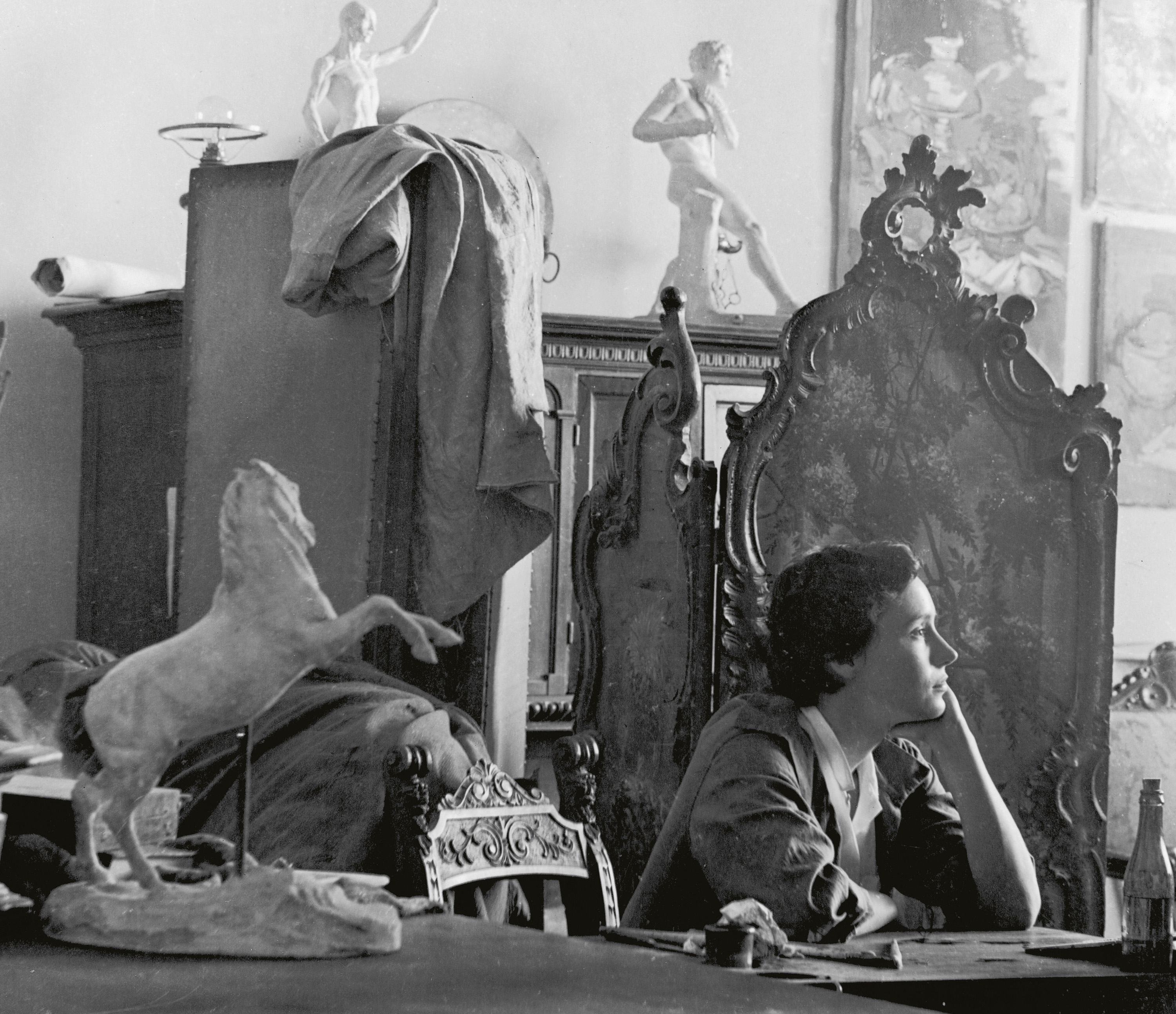
I asked our curator Jennifer Phipps to tell me about Yvonne, as I was keen to learn about her training and background, and her experience as an abstract painter of consummate skill in a city which, at the time, had demonstrated far less interest in abstraction than Sydney. So, what was her story? Jennifer quickly invited Yvonne to visit us in our temporary home in Russell St, during the NGV redevelopment, and I still recall with great clarity our fascinating conversation over several hours, outlining her remarkable and courageous career.
Yvonne arrived in New York at the very moment that the New York School (and Abstract Expressionism in particular) was being recognised as the preeminent global avant-garde. Since then, I have had the privilege of many discussions with Yvonne, for which I am very grateful, as well as the access she has given me to her studio notes and commentaries on the exciting new world she was then encountering. Significantly, when Yvonne arrived in New York in late 1952, the New York School and Abstract Expressionism were hardly known in Australia, even to those artists, mostly clustered in Sydney rather than Melbourne (where figuration remained dominant), who might be seen as representing the Australian avant-garde. When thinking about modernism, most Australian artists still looked to Paris and London first, and it has been said that the term ‘Abstract Expressionism’ first appeared in Australian critical writing in a commentary by Elwyn Lynn as late as 1955.
When Yvonne initially left Sydney, she was really en route to Europe, with New York as an important first stop. It is entirely explicable, therefore, that after nearly three exciting years immersed in New York’s art scene, she decided in 1955 to continue her odyssey, going first to Italy, where in due course she worked in Florence, before the attractions of Milan and the buzz of its postwar avant-gardism drew her north. There, she found influential friends, including the already globally-renowned sculptor Arnaldo Pomodoro, who assisted her in finding a studio, and introduced her to northern Italian abstractionists such as Emilio Vedova. Milan largely remained her base in the decade before she returned permanently to Australia in 1966, though regularly punctuated by visits to New York.
Her experience of the New York School was absolutely fundamental to her artistic practice. No other Australian artist had an opportunity to become absorbed as a part of the New York scene so early in the 1950s. These seminal years were the catalyst for Yvonne to create and refine her personal style, and there can be no doubt that, in her own way, she became a part of that scene. In her notes, Yvonne defines herself as an ‘Abstract Expressionist’, though she eschewed the vigour and layering of impasto paint typical of the ‘action’ painters, preferring instead her personal system of making active, fluid marks on a more thinly painted surface, activated in a more lyrical and considered way, akin to the effect of music.
Indeed, Yvonne had studied at the Sydney Conservatorium of Music before attending art school and, as suggested above, the sense of a correspondence between music and painted form and colour dominated her aesthetic. She describes the exhilaration of working in a studio filled with music, and her great love for Bach above all, whose approach to counterpoint, to contrapuntal and fugal melodies, has always informed her way of working. Above all, she articulates the centrality of musical experience most directly through her ‘Cantata’ paintings, and describes her ‘counterpoint’ arrangements as enabling ‘the mystical experience of space’. Her use of calligraphic marks, signs and implied graffiti defines her style. She studied Zen philosophy both at art school in Sydney (in common with several of her fellow students) and again in New York, and she acknowledges the great influence which Mark Tobey’s Zen-inspired art had upon her – as well as discussions in Rome in 1957 with Cy Twombly about ancient and modern graffiti both on city walls and in the catacombs.
For Yvonne, the matter of ‘gender’ has sadly been an issue, and likely a key reason why this most accomplished and inspiring Australian abstractionist, whose impeccable experience and training at the centre of the global avant-garde should have guaranteed celebrity, has not been better known, or acknowledged earlier than was the case. She describes the effort it took to break into the Australian art world upon her return in 1966, which operated as a kind of ‘boys club’ at the time. Today however, Yvonne is widely recognised as occupying a unique place in Australian art history. In 1999, Doug Hall honoured Yvonne with a major exhibition at the Queensland Art Gallery, curated by Julie Ewington, which was followed by exhibitions at Heide Museum of Modern Art (2000); the National Gallery of Victoria (2007 – 2008); and the Ian Potter Museum of Art at Melbourne University (2009). There will no doubt be many more. At present, the Art Gallery of New South Wales is displaying a pair of her works from the early 60s on facing walls, in close proximity to major pictures by Picasso and Bacon, which works well and feels entirely appropriate.
The group of works being offered by Deutscher and Hackett are among her very best, all of high museum quality, and retained until now for personal reasons. At 93, she feels the time has come to make them available to a wider audience.
YVONNE AUDETTE | The Expatriate Years
DR CHRISTOPHER HEATHCOTE
AUDETTE Expat full (010b)_(large) cmyk.jpg
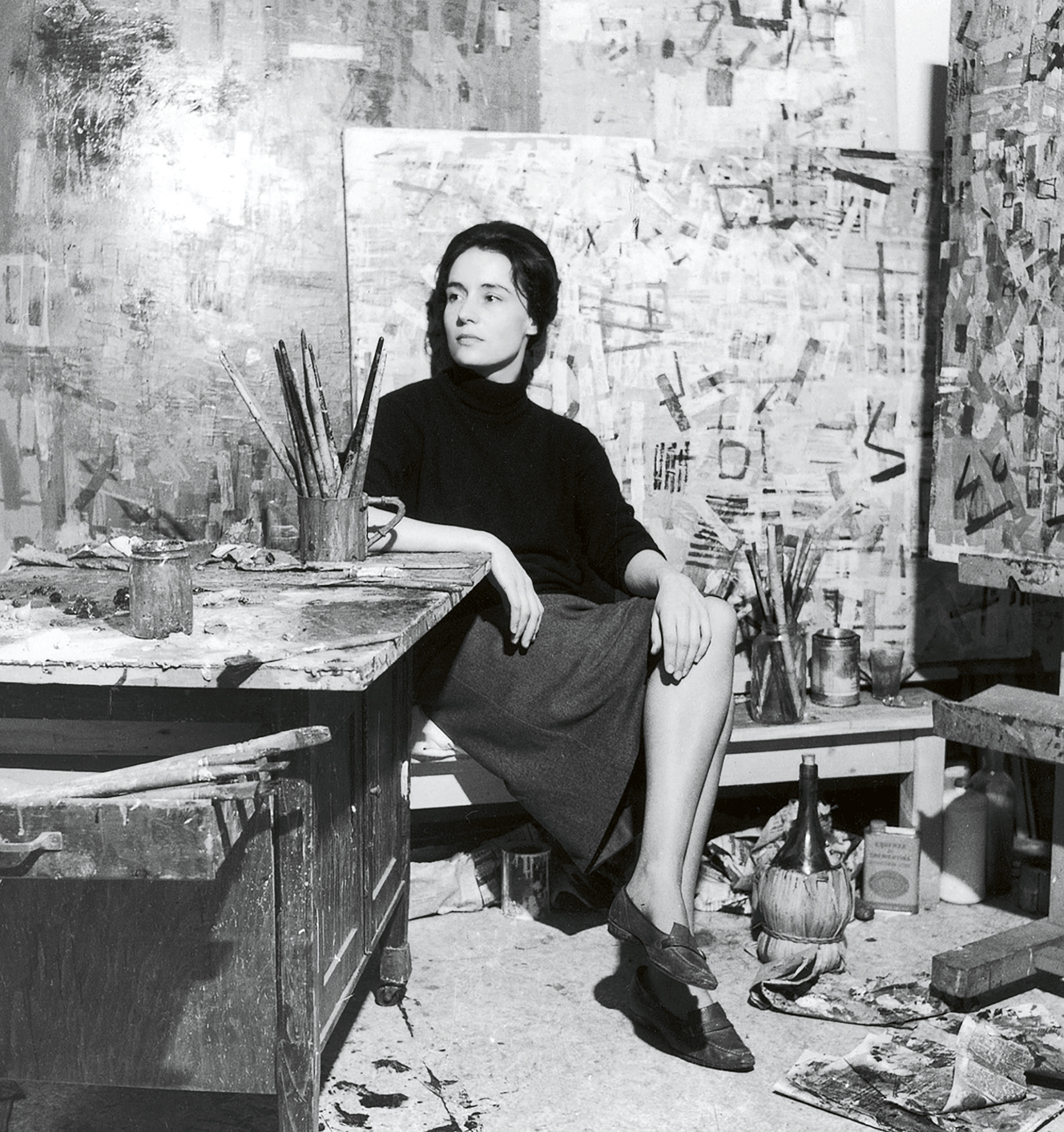
Nothing since has compared with the thrill of spotting her overlooked talent. It was June 1994, I was The Age’s art critic, and one wet afternoon I came upon an exhibition that took my breath away. Ten authoritative Abstract Expressionist paintings from the 1950s and 60s were displayed around two rooms in North Melbourne. ‘The neglect of Yvonne Audette must rank as one of the great injustices in Modern Australian Art,’ my review of that show began. Little did I realise the attention my piece on this local artist would spark; indeed, curators from the National Gallery of Australia, National Gallery of Victoria and Queensland Art Gallery quickly made a beeline for the gallery.
Audette’s story was fascinating. Having completed the traditionalist studio program at Sydney’s Julian Ashton School, as well as receiving expert instruction from John Passmore—a disciple of Cézanne—the 22-year-old had intended to take that rite of passage then followed by rookie artists. It was customary to sail for London and spend time absorbing British culture, after which a young Australian might roam the art capitals of Europe. Audette expected to do likewise. But her American-born father offered to fund her travels provided she went first to the United States. Accordingly, when the artist departed Sydney in October 1952, her destination was New York.
Art Sup Image AUDETTE 05.jpg
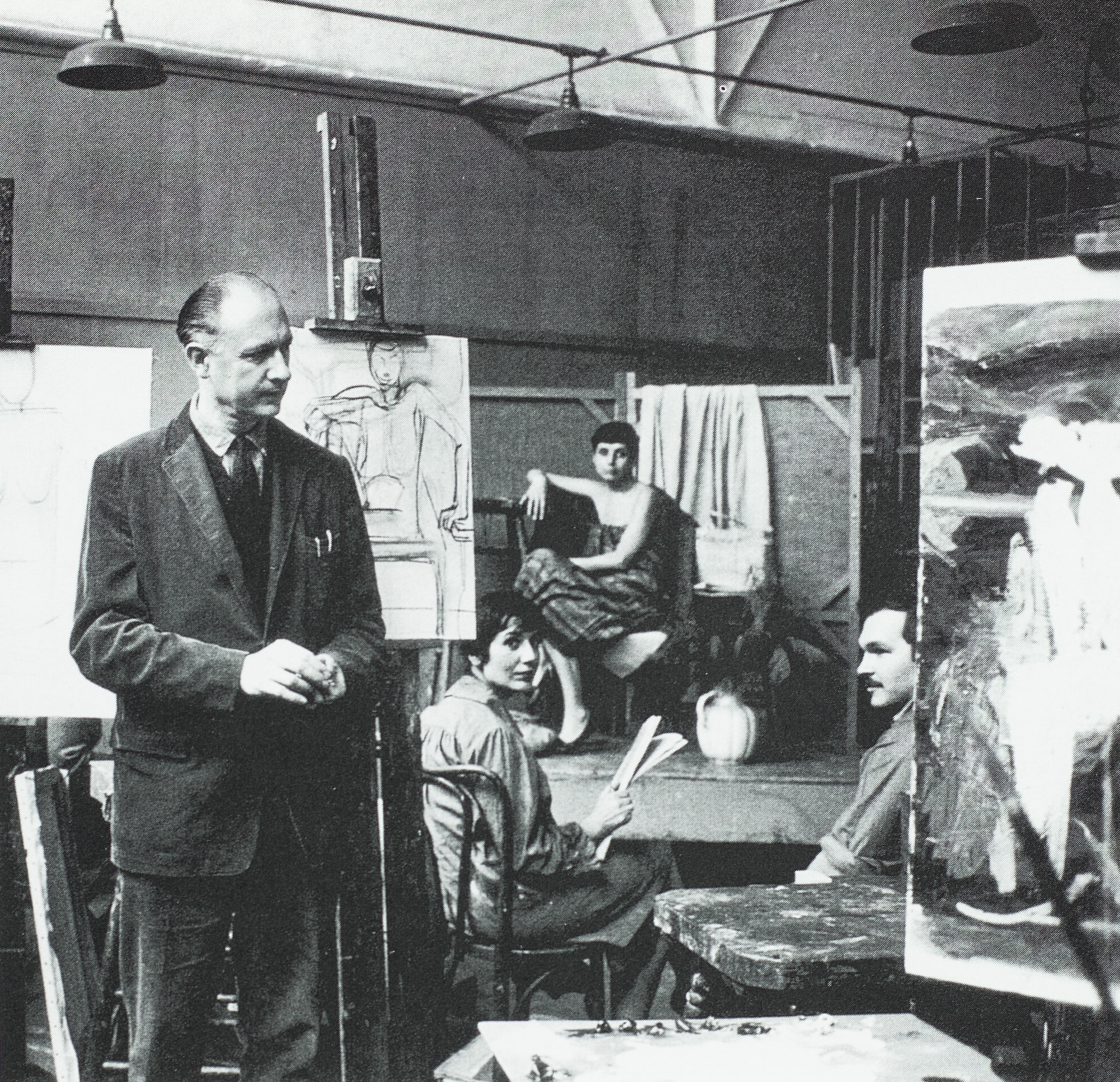
New York, 1950s
Yvonne Audette arrived in the city at a decisive moment. A new movement, nicknamed ‘Abstract Expressionism’ by the New York Times, had broken out across the art scene. In fact, within weeks an exhibition opened which changed the course of modern art. Audette, who had enrolled in the painting program at the conservative New York Academy of Design, heard from other students that one of the movement’s leaders, Willem de Kooning, was showing paintings of female figures. Curious, she tagged along when her classmates went to see his work at Sidney Janis Gallery on East 57th Street, the hub of Manhattan’s commercial gallery district.
Audette told me she was shocked and confused at the gallery; and also strangely overwhelmed. Having herself mastered the classically-based academic manner, de Kooning’s abstracts looked to her like a hoard of destructions. Six large scale Woman paintings hung around the main room, with another thirteen pastels and a pencil drawing on the same theme, as well as two small oils, displayed in a side gallery. To coincide with the show ArtNews magazine published an article, ‘De Kooning Paints a Picture’, which used in-progress photographs taken in his studio to trace the creative evolution of a key exhibit. The Australian pored over those illustrations and began visiting the venues which showed this stirring new form, wanting to understand.
AUDETTE EXPAT YEARS Elaine and Willem De Kooning, 1953 _cmyk.jpg
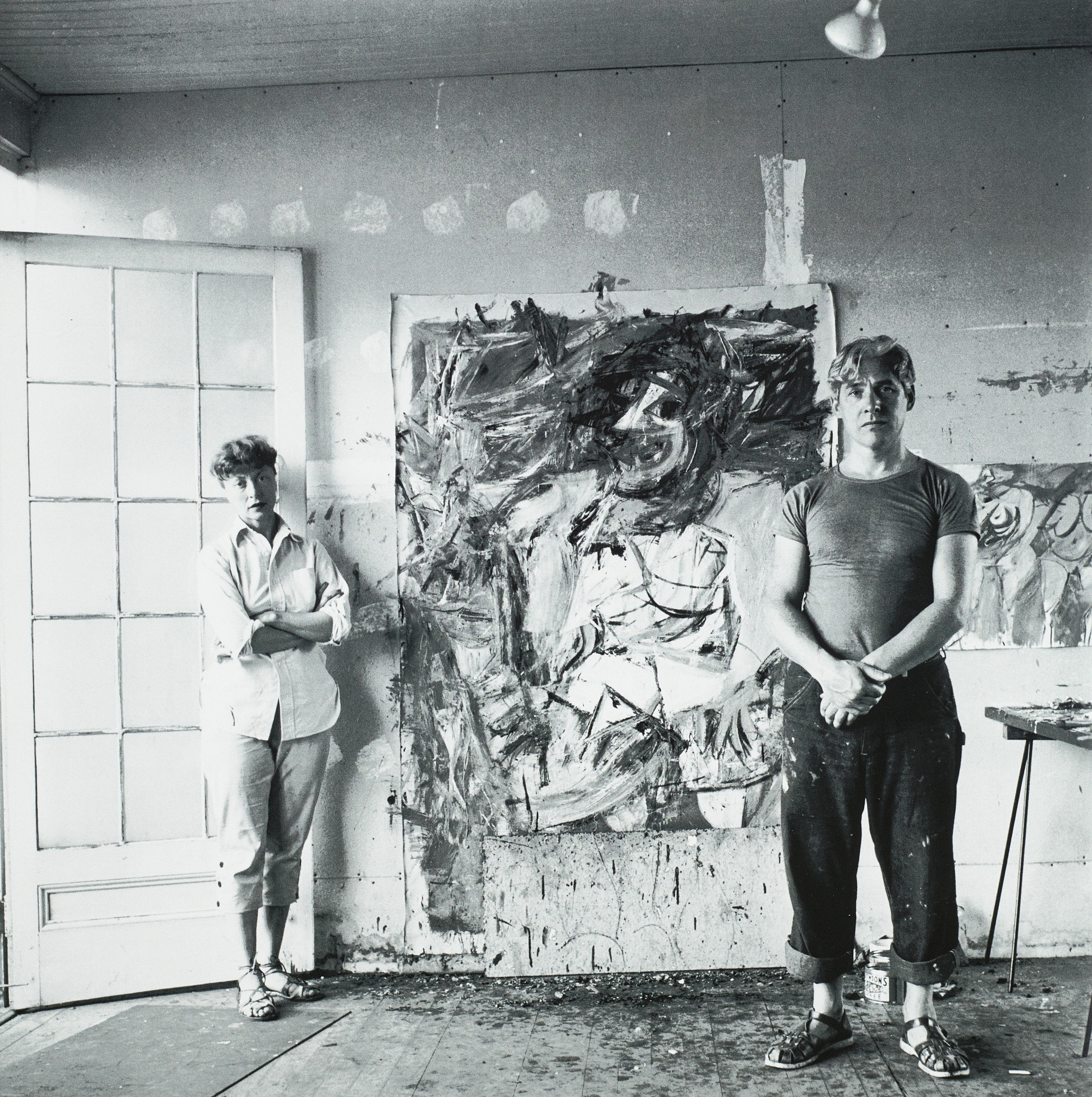
Eighteen months later Yvonne Audette was herself painting New York-style abstractions. Overpass 2, 1954 shows her laying down thickened oily paint in earth colours, greys and black with brushes and painting knives. In keeping with vanguard values, which held that energised line alone was sufficient to convey visual meaning, Audette worked the viscous pigment into broad expressive marks and gestural scrapes. Using a palette which smacks of brickwork, concrete and rusted steel while composing with those jagged, structured forms of interweaving roadways, apartment buildings and elevated railways, her self-assured composition evokes inner-city experience.
Spring 1955 saw Audette now make her way to Europe. After roaming through Spain, France then Italy, she took a studio in Florence and began working toward a show: ‘Living in that great town,’ she said, ‘taught me that art is wrought out of day-to-day labour, out of constant application...’ Interest in the new abstraction was strong in Italy, and from 1958 Yvonne Audette averaged a solo exhibition there every year.1 During her first show, at Galleria Schettini in Milan, the rising young sculptor Arnaldo Pomodoro asked to be introduced. He would soon bring her into a circle of vanguard artists, including the leading painters Emilio Vedova, Renato Birolli and Gastone Novelli. Thrilled to meet an artist familiar with New York, they always wanted to know her opinion when American Abstract Expressionism was exhibited in museums at Milan, and the Venice Biennale.2
These years saw Audette’s own studio work straddling American and European values. She took to painting on wood panels as they offered a firm support for her increasingly fine layers of brushed, trowelled, smeared and scraped pigment. Instead of continuing with that loose spontaneity of New York ‘action painting’, where a work was produced mostly in a single fervent session, Audette now deliberated upon a composition, crafting the increasingly supple paintwork over months. Her stress was on steady control.
AUDETTE Expat P4 (010a)_cmyk.jpg
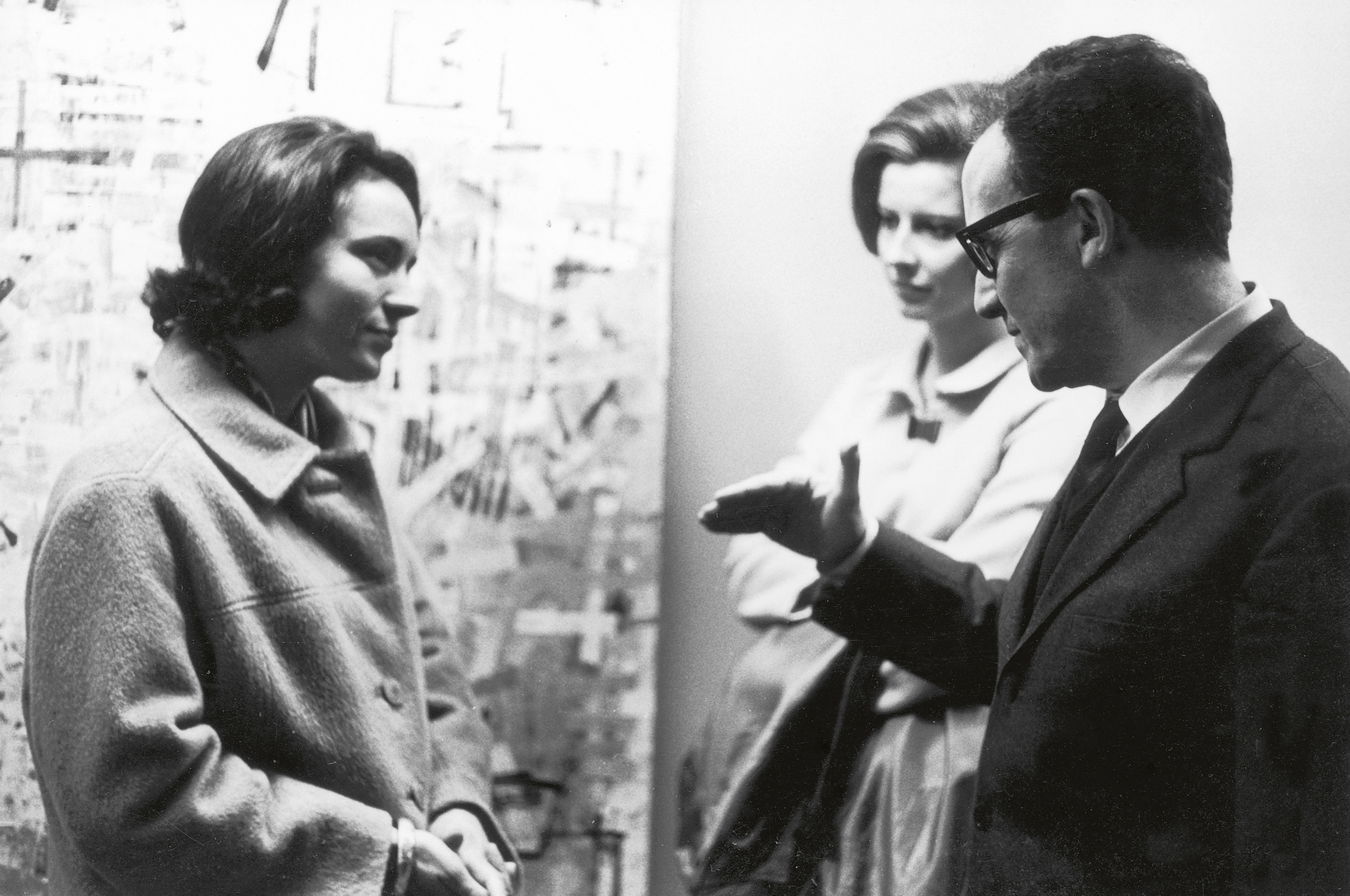
Rome, 1965
We see this very strikingly in Different Directions, 1964, where unrushed surface brushstrokes of blue, black, green, brown and yellow are carefully positioned upon a semi-transparent chalk white field. Initially the eye attends to the animation of those marks, how they dance in different ways and speeds. But behind an immediate linearity there is a distinct feeling here for the importance of placement. The coloured strokes will be positioned so each retains its own value, the artist wanting her marks to perform in this elegant painting like individual notes in a serene melody. It was in these years Yvonne Audette began to liken making her abstractions to composing music.
AUDETTE Expat Pomodoro.jpg
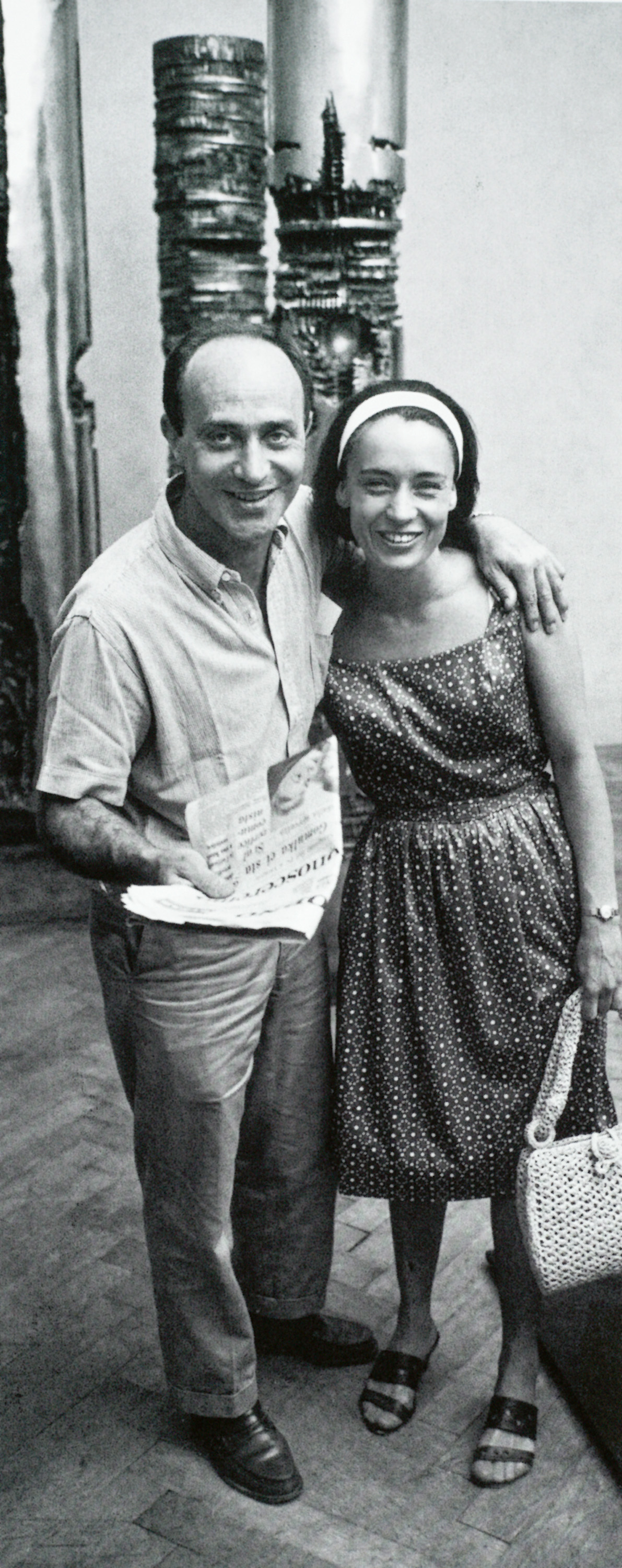
Yvonne Audette with Arnaldo
Pomodoro in the Italian Pavillion
after Arnaldo received the prize
for sculpture at the Venice Biennale,
1964
The Italian artists Audette mixed with were intrigued with simple marks which acted as signs, as in exclamation marks, drawn arrows, and diagram notations. She is seen responding to this with The Spirit Laughs of 1964, exhibited at Galleria Schneider, Rome in 1965 – one of several compositions which began with a surface layer recalling yellowing parchment. The artist next applied a loose arrangement of semi-diagrammatic marks. Once the pigment dried they were thinly painted over, and the process repeated several times. The finished quite joyous work resembles an index of Audette’s brushstrokes: we see iterated blue strokes and brown hatchings, rough crosses and V-shapes, broken squares and lopsided circles, zigzags, a meander, plus assorted repetitious dashes, all of them intended to suggest marks associated with human habitation across the ages. There is no mistaking the pleasure the artist took in crafting this upbeat work: the very lines exude merriment.
Audette kept in touch with her Sydney teacher John Passmore. The pair regularly corresponded, and Passmore visited her on a trip to Europe. So it is little surprise a subtle allusion to his oeuvre crept into Audette’s overtly International abstractions in the mid-1960s. Take The Music Score, 1967, a handsome composition where blue and black strokes tilt across upon a pale grey field of trowelled paint. That backdrop comprises loose oblongs of grey and umber blended in a manner echoing Passmore’s flattened paint slabs hanging in space. Audette uses the field to assert gravity, giving a downward pull that her lively strokes of colour react against. The outcome is testimony to how Yvonne Audette could not only blend International with regional concerns in a skilled manner, but how she has always aimed to craft works of beauty.
1. Audette held two solo shows in Milan (Galleria Schettini 1958, 1964), another two in Rome (Galleria Schneider 1965, 1966), and three in Florence (Galleria Numero 1958, 1959, 1963), as well as one each in Paris (Gallery L’Antipoete, 1961) and London (Hamilton Gallery, 1964).
2. A large survey exhibition of Abstract Expressionism, organised by New York’s Museum of Modern Art, was held in Milan’s Galleria Civica d’Arte Moderna in June 1958. The American abstract artist Mark Tobey also represented America in that year’s Venice Biennale, where he took the main prize.
YVONNE AUDETTE | Return to Australia
KELLY GELLATLY
The Australia that Yvonne Audette returned to in 1966 at the age of thirty-six was a vastly different place to the country she had left as a young and ambitious artist in 1952. Longstanding Prime Minister Robert Menzies retired in January and was replaced by Harold Holt (who went on to win a landslide victory in the November election); decimal currency was introduced; Jørn Utzon resigned as architect of the Sydney Opera House, and in late August, 200 Gurindji people walked off Wave Hill Station in the Northern Territory in an unprecedented protest against low wages and poor working conditions. 1966 also marked the fourth year of Australia’s involvement in the Vietnam War.
AUDETTE Return full_cmyk.jpg
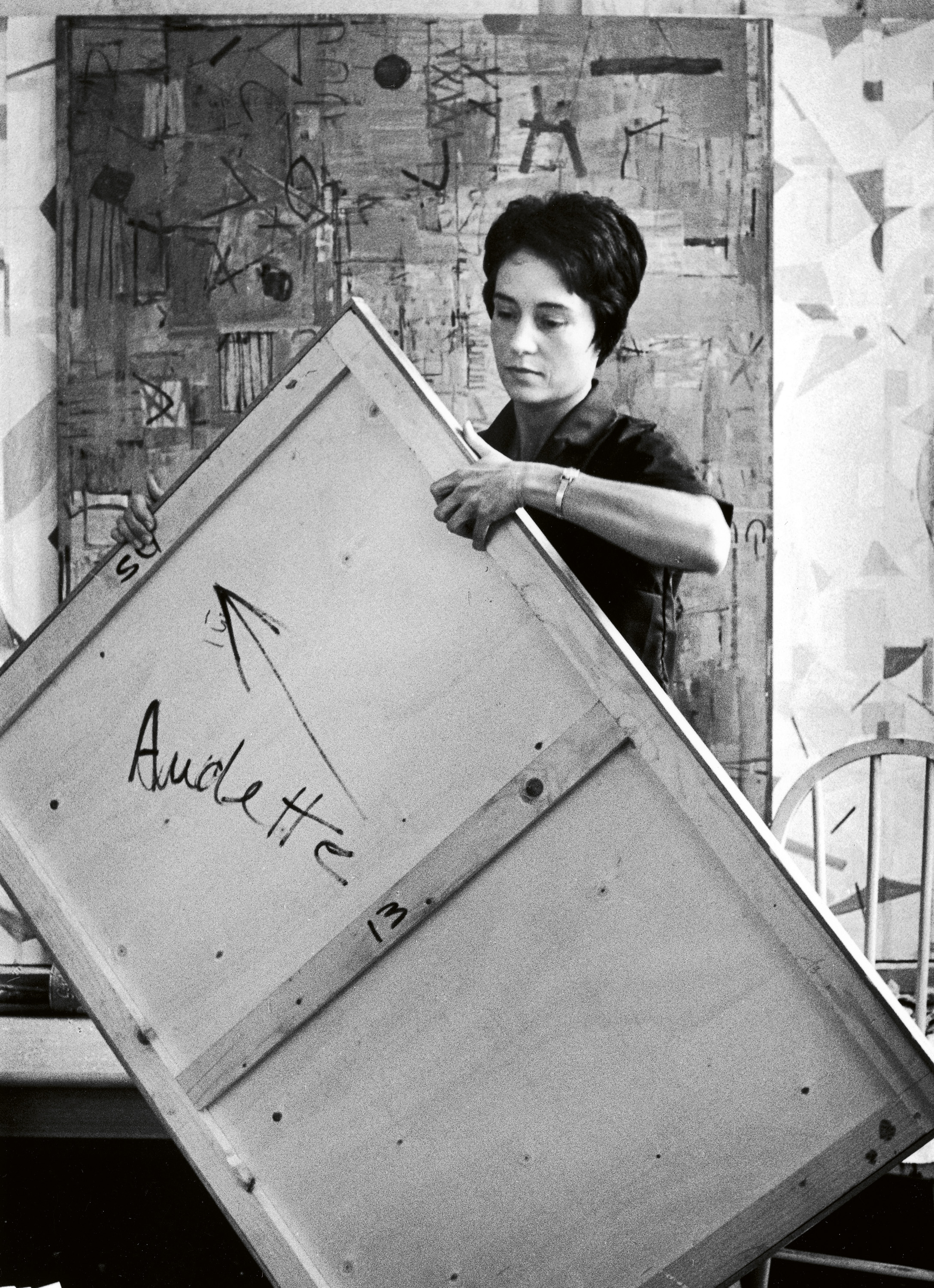
Change was equally happening in the art world. The landmark Museum of Modern Art exhibition Two Decades of American Painting – which included the work of artists ranging from Jasper Johns and Andy Warhol to Barnett Newman and Helen Frankenthaler – had travelled to the National Gallery of Victoria and the Art Gallery of New South Wales in 1967, and abstraction was now a well-accepted part of the local scene. Indeed, with the opening of The Field exhibition at the new National Gallery of Victoria just two years after Audette’s return, Colour Field painting and hard-edge abstraction were the pervading influence – reinforced and promulgated by the 1968 lecture tour of American art critic Clement Greenberg, who was described by Bernard Smith as ‘the critical god of abstraction.’1
AUDETTE Return p3 2_cmyk.jpg
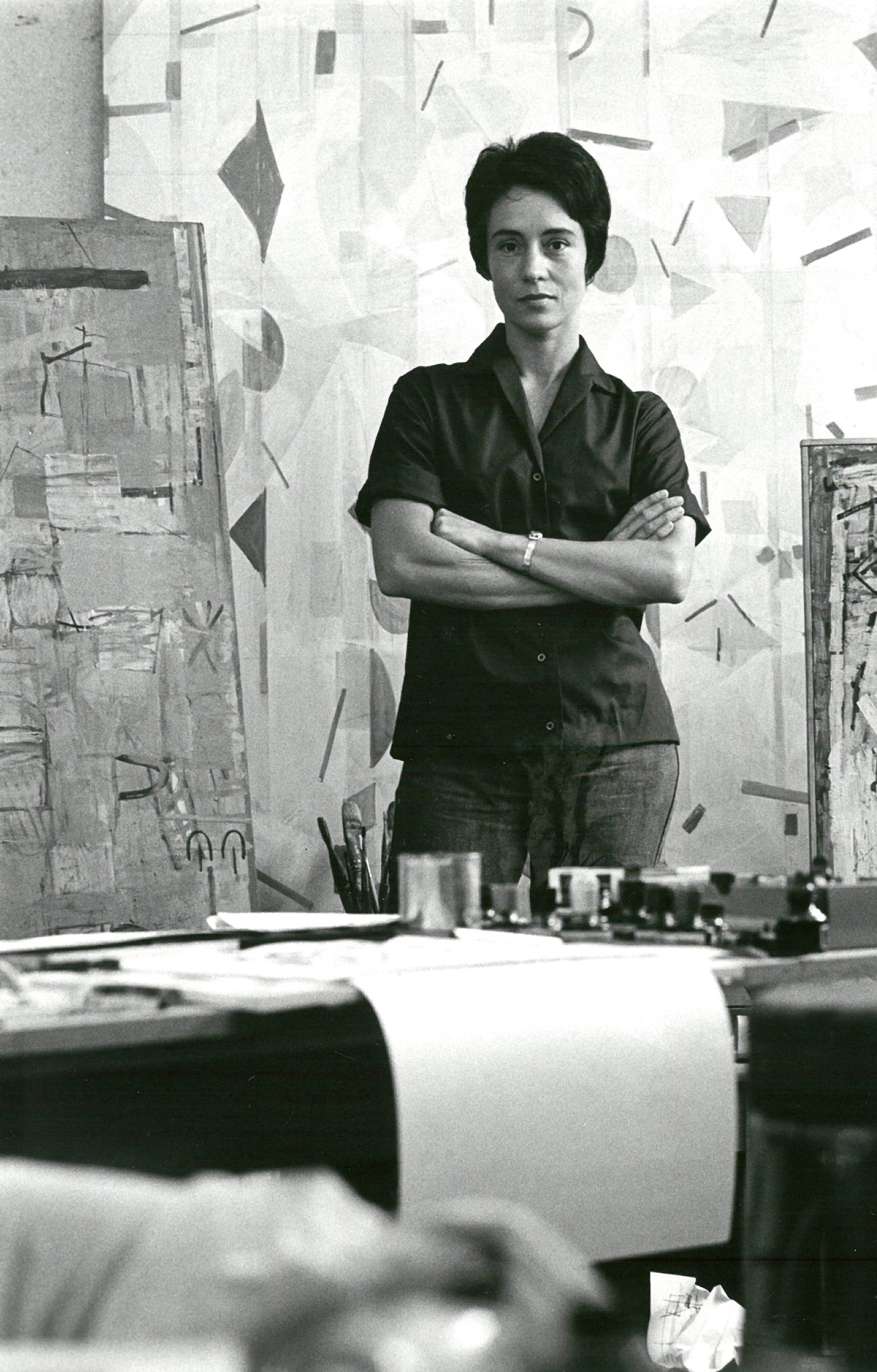
Yet one can imagine that after experiencing the heights of the art worlds of both New York and Europe, Audette’s transition to life in Sydney, even despite these changes, was not an easy one. Just as Australia was looking to the influence of American abstraction, she had returned home, seeking separation, in her words, from ‘all those countries rich in the impregnation of man’s mind and hand through the centuries, where man’s spirit has caressed every stick and stone and almost every plot of land.’2 Australia seemed to provide Audette with an opportunity to find her own voice unencumbered, and to importantly, return to nature. As she continued:
‘Out here there is a challenge to the self. Away from the spirits of those old cultures one must delve into the mainstream of oneself, deeply, and find there another “heritage” that could breed independence of thought and spirit. It is this which excites me now, as never before, to find the spirits in our own climate which have their own story.
I think it’s an artist’s job to discover a new vision – but to do this one has first to have an attitude of independent thinking. Out here I feel one has perhaps a better perspective, a greater chance of independence.’3
Audette established herself in Sydney’s Rose Bay, holding an exhibition of her work at Bonython Galleries in February 1968 with friend and fellow artist Robert Klippel, who she had first met through John Passmore in the late 1950s. Klippel had also been central to her ability to retain, and importantly, store the paintings that she had shipped home from Europe, providing a room in his home in Birchgrove for her to house her earlier work.4 This established a lifelong practice for Audette of retaining important, key pieces from across her oeuvre, which served as both a source of inspiration and an aide de memoire for work in coming decades. It is for this reason too that later museum audiences have been able to experience such a rich selection of work from her time in Europe, which would have been otherwise almost impossible to reconvene for Australian exhibitions.
However, just one year after this successful reintroduction to the Australian scene, Audette moved to Melbourne, settling in the Dandenong Ranges. Isolated from the city’s galleries and art community, her desire to immerse herself in nature, and through this, concentrate wholly on her practice, had become a reality. As she explained at the time:
AUDETTE Return p3_cmyk.jpg
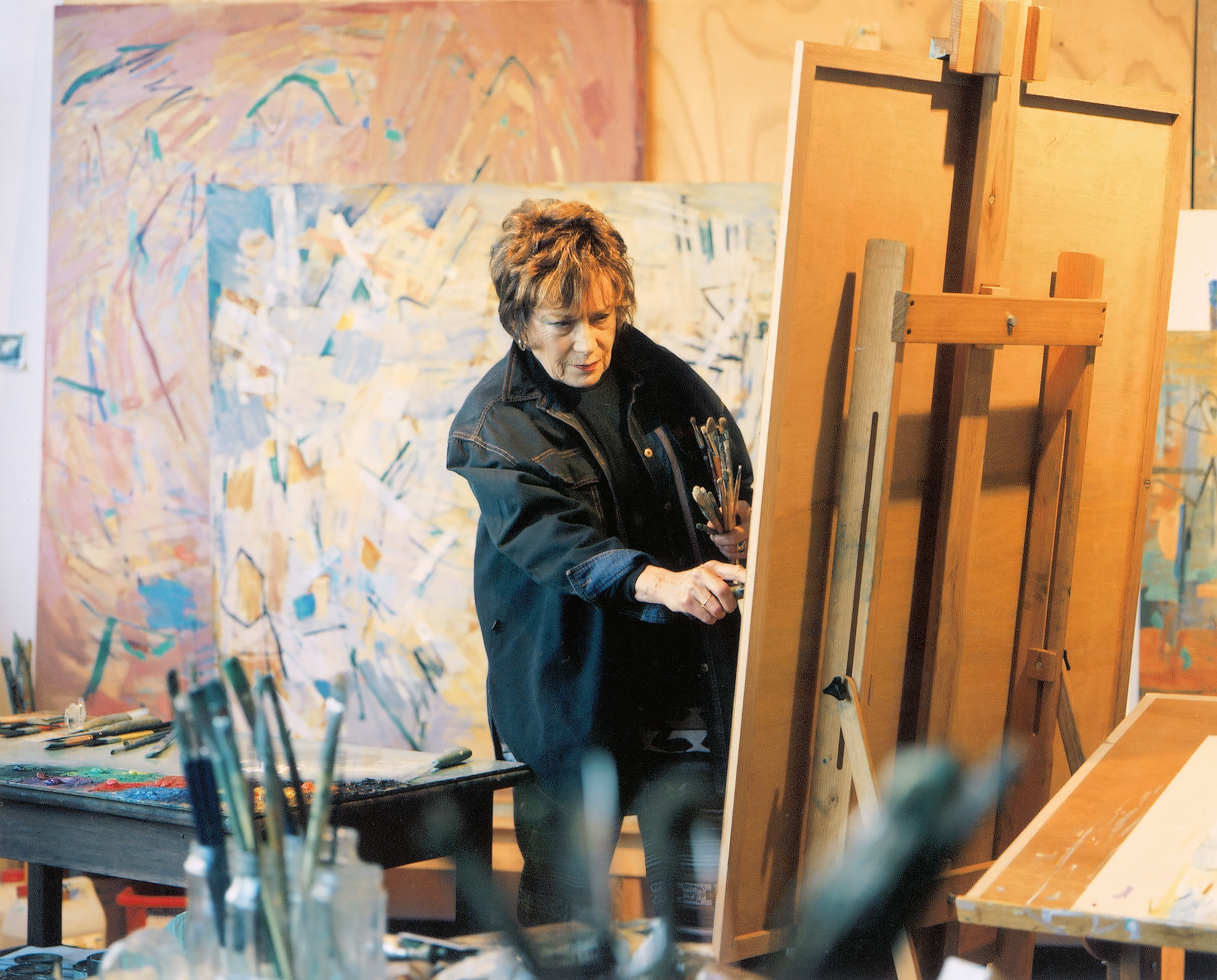
‘I chose the Dandenong Ranges where I could be close to nature, surrounded by the landscape. Having travelled and moved since 1952, from city to city, I had never lived in the bush, never had I allowed myself the luxury to wake up to the sounds of nature at my doorstep. I knew to develop more profoundly as an artist and as a person, I needed the stillness and silence of the landscape and the closeness of the wildlife. I needed to experience my outer space and my inner space up in the high country.’5
This site was to remain Audette’s home and studio until a decade or so ago. Accessible by a narrow dirt road and perched high on a hill, her large light-filled studio had an enormous window that looked out, over the valley, creating the sense that one was soaring above the landscape, and equally, that this vista was an extension of the artist’s working space. This environment was not without its challenges and sacrifices however, as each bushfire season saw the paintings shipped to storage in Melbourne to both ensure their safety and quell Audette’s anxieties about the risk of their potential loss. Surrounded by treasures that she had collected on her travels, Audette also assumed the role of teacher in this space, continuing the tradition and commitment of her own teachers and mentors as she ran composition workshops from home, while also teaching Saturday morning life drawing classes in the Melbourne suburb of Hawthorn.6
AUDETTE (NEW) Gallery shot_cmyk.jpg
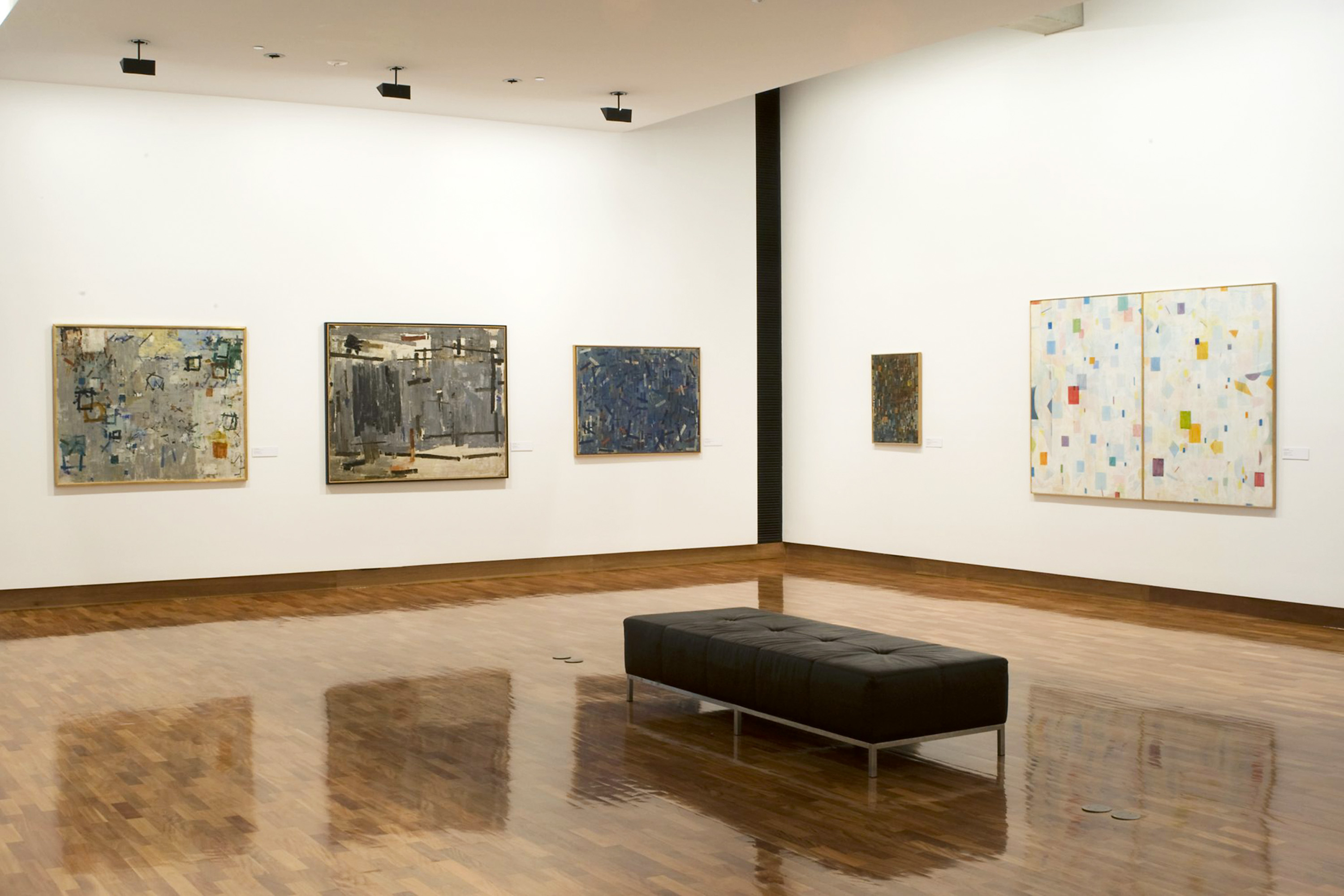
Successful commercial exhibitions continued throughout the 1970s and 80s, but as taste and fashions changed, knowledge of Audette’s work became largely restricted to a small, dedicated audience. It was not until the artist’s 1999 exhibition, Yvonne Audette: Abstract Painting 1950s – 1960s at Queensland Art Gallery (curated by Julie Ewington) that a wider public came to recognise both the depth and breadth of her practice, and the significance of her contribution. Not surprisingly, further museum exhibitions followed: at Heide Museum of Modern Art (2000), at the National Gallery of Victoria (2007), and at the Ian Potter Museum of Art at the University of Melbourne (2009). Now widely collected in Australian art museums, Yvonne Audette is today celebrated for her dedication to her craft, for her unique visual language, and for the singular position she holds in the story of Australian art.
1. Bernard Smith was responsible for bringing Clement Greenberg to Australia to deliver the inaugural John Power Lecture at the University of Sydney. Skerrit, H. F., ‘Bernard Smith 1916 – 2011’, Art Guide Australia, November/December 2011, pp. 48 – 50, ‘Henry F. Skerritt’, https://henryfskerritt.com/tag/clement-greenberg/, accessed 27 August 2023
2. The artist, cited in Thomas, L., ‘The mainstream of self’, The Australian, 24 February 1968 in Adams, B., ‘Yvonne Audette, The Later Years’ in Heathcote, C. et al., Yvonne Audette: Paintings and Drawings 1949 – 2014, Macmillan Art Publishing, Melbourne, 2014, p. 155
3. ibid.
4. Adams, B., ‘Yvonne Audette, The Later Years’ in Heathcote et al., op. cit., p. 155
5. The artist’s notes, February 2003, cited in Adams, ibid., p. 163
6. Vaughan, G. & K. Grant, ‘Every Day a Drawing: Yvonne Audette’s Works on Paper’ in Heathcote et al., op. cit., p. 243
BACK TO CATALOGUE